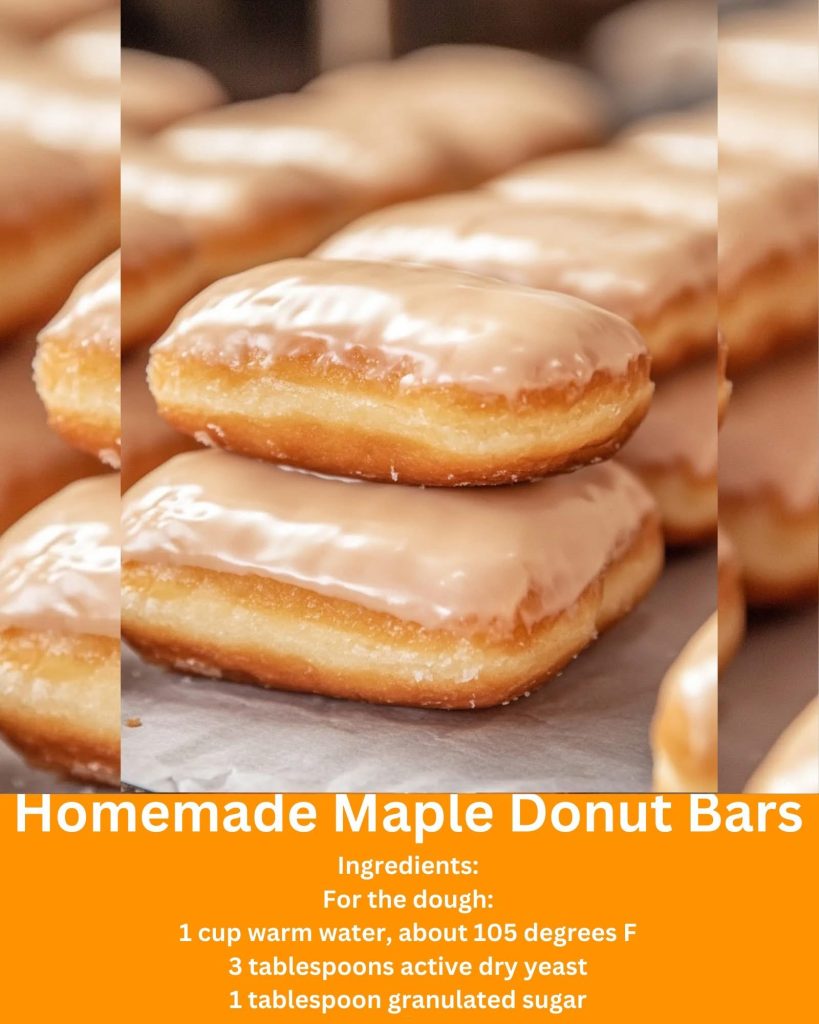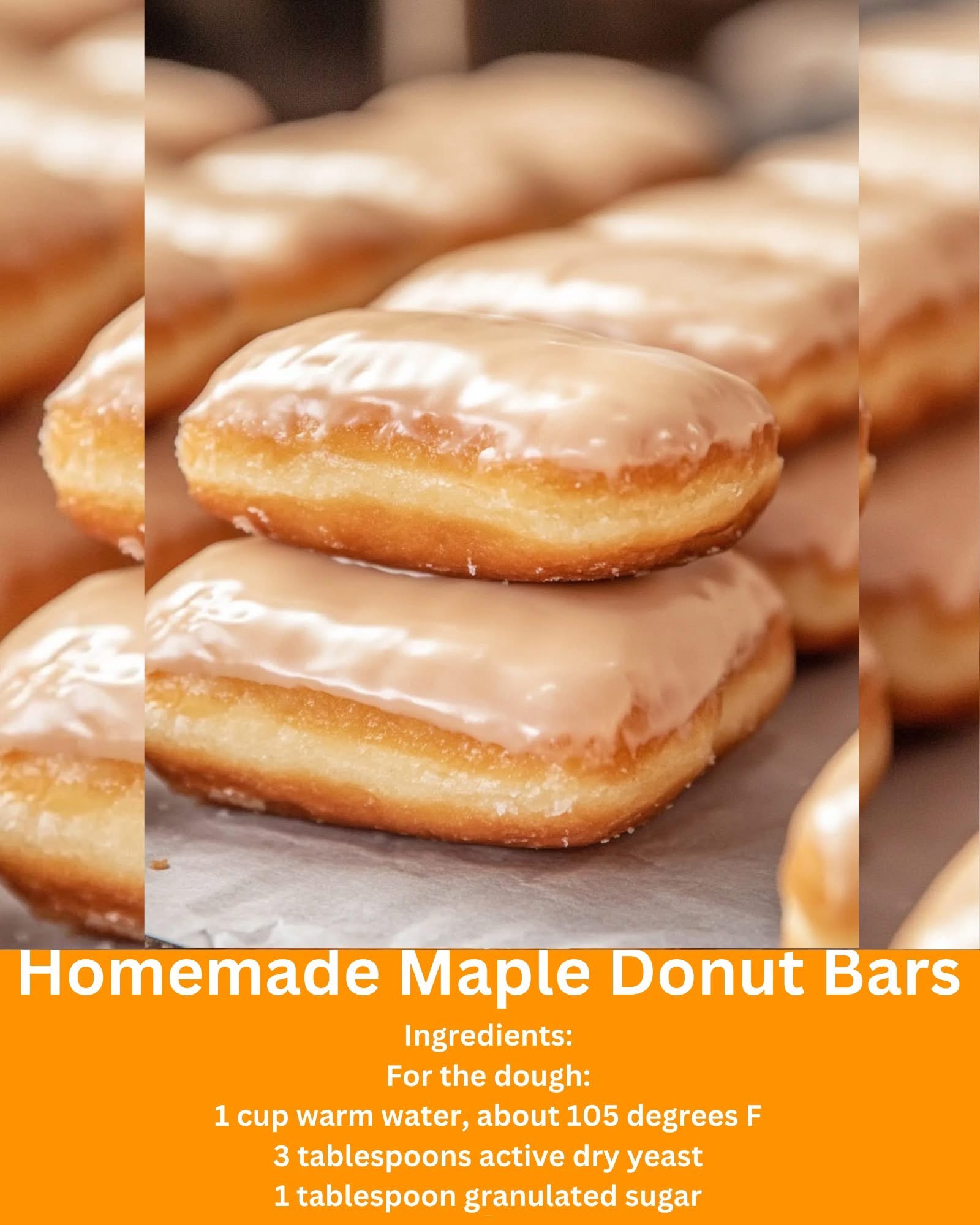
Homemade Maple Donut Bars
Introduction
Maple donut bars are a classic bakery treat known for their soft, pillowy texture and rich, maple-infused glaze. Originating from traditional yeast donuts, these bars have become a favorite across North America, particularly in the Pacific Northwest and Canada, where maple syrup is a staple.
Homemade versions allow for customization, ensuring the perfect balance of sweetness and texture. Whether enjoyed with a morning coffee or as an indulgent dessert, these maple bars are sure to impress!
Ingredients
For the Dough:
• 1 cup warm water (about 105°F)
• 3 tablespoons active dry yeast
• 1 tablespoon granulated sugar
• 3 ½ cups all-purpose flour
• ½ cup whole milk
• ⅓ cup unsalted butter, melted
• ¼ cup granulated sugar
• 2 large eggs
• 1 teaspoon salt
• 1 teaspoon vanilla extract
• Oil for frying
For the Maple Glaze:
• 2 cups powdered sugar
• ¼ cup unsalted butter, melted
• ⅓ cup maple syrup
• 1 teaspoon vanilla extract
• 2-3 tablespoons milk (adjust for consistency)
Instructions
Step 1: Activate the Yeast
1. In a small bowl, combine warm water, yeast, and 1 tablespoon of sugar.
2. Stir gently and let sit for 5-10 minutes until the mixture becomes foamy.
Step 2: Prepare the Dough
1. In a large mixing bowl, whisk together the flour, remaining sugar, and salt.
2. In another bowl, mix warm milk, melted butter, eggs, and vanilla extract.
3. Add the yeast mixture to the milk mixture and gradually incorporate it into the dry ingredients.
4. Knead the dough for about 8-10 minutes until smooth and elastic.
5. Place the dough in a greased bowl, cover, and let it rise in a warm place for 1 hour or until doubled in size.
Step 3: Shape the Doughnuts
1. Roll out the risen dough on a floured surface to about ½-inch thickness.
2. Cut into rectangular bars using a knife or pastry cutter.
3. Place the cut pieces on a parchment-lined baking sheet, cover, and let rise for another 30-45 minutes.
Step 4: Fry the Doughnuts
1. Heat oil in a deep fryer or heavy-bottomed pot to 350°F (175°C).
2. Fry the bars in batches, cooking each side for 1-2 minutes until golden brown.
3. Remove and drain on a wire rack lined with paper towels.
Step 5: Prepare the Maple Glaze
1. In a bowl, whisk together powdered sugar, melted butter, maple syrup, vanilla extract, and milk until smooth.
2. Adjust the milk quantity for desired glaze thickness.
Step 6: Glaze the Doughnuts
1. Dip each donut bar into the maple glaze while still warm.
2. Place on a wire rack and let the glaze set before serving.
Troubleshooting & Expert Tips
Why Didn’t My Dough Rise?
• Make sure the yeast is active; if it doesn’t foam when mixed with warm water and sugar, it may be expired.
• Ensure the rising environment is warm (around 75-85°F).
How to Get a Fluffier Donut?
• Knead the dough well to develop gluten, which gives structure.
• Allow sufficient rising time to achieve an airy texture.
Preventing Oily Donuts
• Maintain a consistent frying temperature (350°F). If the oil is too cold, the donuts absorb excess oil.
How to Make the Glaze Thicker or Thinner?
• Add more powdered sugar for a thicker glaze.
• Add more milk for a thinner glaze.
Variations & Additions
Baked Maple Donut Bars
If you prefer a healthier alternative:
1. Preheat the oven to 375°F (190°C).
2. Place the shaped bars on a lined baking sheet.
3. Bake for 12-15 minutes until golden brown.
4. Let cool before glazing.
Maple Bacon Donut Bars
For a sweet-savory twist:
• Sprinkle crispy bacon bits on top of the glaze.
• The smoky bacon enhances the maple flavor beautifully.
Chocolate Maple Donut Bars
• Add ¼ cup cocoa powder to the dough for a chocolate-flavored bar.
• Drizzle melted chocolate over the maple glaze for a rich finish.
History of Maple Donuts
Maple syrup has been a cherished ingredient since the early days of Native American tribes, who first discovered the process of tapping maple trees for sap. The use of maple in pastries became widespread in the 19th and 20th centuries as it was a readily available sweetener. Today, maple bars remain a signature treat in American and Canadian bakeries.
Health Benefits of Homemade Donuts
• No Preservatives – Unlike store-bought donuts, homemade versions are free from artificial additives.
• Customizable Ingredients – You can control the sugar, flour type, and toppings.
• Rich in Energy – Carbohydrates from the dough provide quick energy.
• Good Source of Protein – Eggs and milk add protein content.
Nutrition Facts (Per Donut Bar)
• Calories: 350-400 kcal
• Carbohydrates: 50g
• Protein: 5g
• Fat: 18g
• Sugar: 25g
• Fiber: 1g
(Nutrition values may vary based on portion size and ingredients used.)
Serving Suggestions
• Serve warm with a cup of coffee or hot chocolate.
• Pair with vanilla or caramel-flavored iced coffee for a sweet treat.
• Top with crushed nuts or extra maple drizzle for added texture.
Who Loves Maple Donut Bars?
• Coffee Enthusiasts – The sweetness of the maple glaze pairs beautifully with the bitterness of coffee.
• Dessert Lovers – Those who enjoy classic donut shop treats.
• Families – A fun, homemade treat for kids and adults alike.
• Bakers & Experimenters – Anyone looking to explore homemade yeast donuts.
Conclusion
Homemade maple donut bars bring the bakery experience to your kitchen with fresh, fluffy dough and a sweet, silky glaze. With their irresistible taste and endless customization possibilities, they are perfect for breakfast, dessert, or a special treat.
